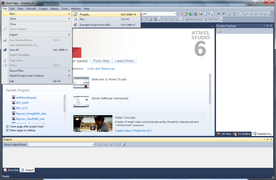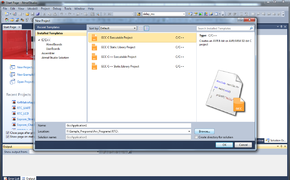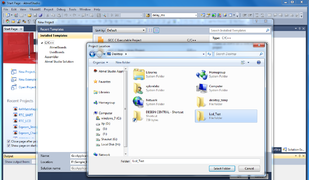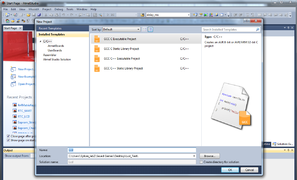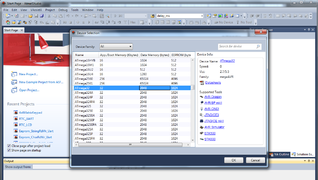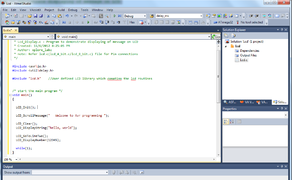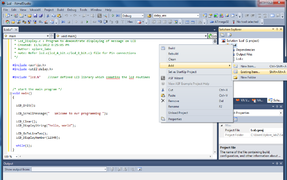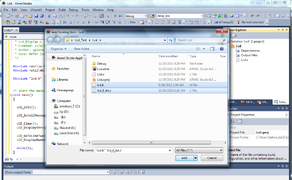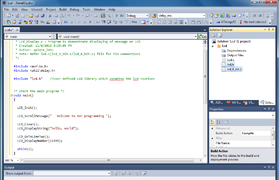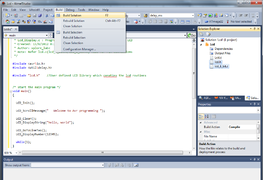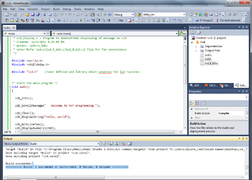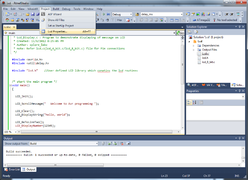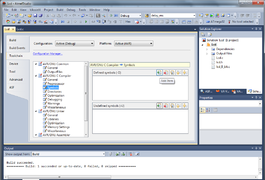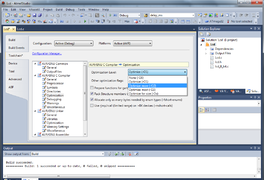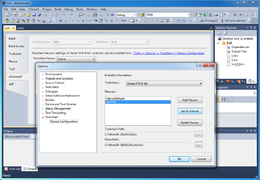Difference between revisions of "AVR Hardware and Software Setup"
m (Sandeep moved page 4.AVR Hardware and Software Setup to AVR Hardware and Software Setup: clean names) |
|||
| (15 intermediate revisions by 2 users not shown) | |||
| Line 2: | Line 2: | ||
[[Category:AVR Tutorials]] | [[Category:AVR Tutorials]] | ||
[[File:AVR_tools_SW_HW.JPG|x250px|Hardware and SW Tools]] | [[File:AVR_tools_SW_HW.JPG|x250px|Hardware and SW Tools]] | ||
| − | |||
| − | |||
In this tutorial we will look at the basic setup required to get started with AVR series of microcontrollers. There are two aspects to it, the software and the hardware. Fortunately, we for AVR there are free software tools available and even some of it is open-source! In this entire tutorial series we will be demonstrating the hardware on aspects on Ultra AVR Development board and also on breadboard and Starter AVR development board wherever possible. Having said that we will release all the schematics and code for you to hack and build on your own. | In this tutorial we will look at the basic setup required to get started with AVR series of microcontrollers. There are two aspects to it, the software and the hardware. Fortunately, we for AVR there are free software tools available and even some of it is open-source! In this entire tutorial series we will be demonstrating the hardware on aspects on Ultra AVR Development board and also on breadboard and Starter AVR development board wherever possible. Having said that we will release all the schematics and code for you to hack and build on your own. | ||
| − | + | ||
=Software= | =Software= | ||
{{Box|type=l_green_light|text= | {{Box|type=l_green_light|text= | ||
| Line 15: | Line 13: | ||
}} | }} | ||
==Setting up Atmel Studio 6:== | ==Setting up Atmel Studio 6:== | ||
| + | * The first section '''Creating a new project''' describes, a fresh new project without any additional configurations. | ||
| + | * The second section show '''importing libraries''', this would be helpful if you're trying to use library files created by Explore Embedded or anyone else and importing them in your projects. | ||
| + | * The third section show '''very important additional configurations''' that you need to make in order to compile and run the programs the right way. | ||
| + | ===Creating a new project=== | ||
<gallery mode="packed-overlay"> | <gallery mode="packed-overlay"> | ||
| − | File:Image001.png| | + | File:Image001.png|Step 1 |
| + | File:Image002.png|Step 2 | ||
| + | File:Image003.png|Step 2 | ||
| + | File:Image004.png|Step 3 | ||
| + | File:Image005.png|Step 4 | ||
| + | File:Image006.png|Step 5 | ||
| + | File:Image007.png|Step 6 | ||
| + | </gallery> | ||
| + | |||
| + | ===Importing Library files=== | ||
| + | Steps below show how to set up AVR studio the right way and import a Explore Embedded Library files | ||
| + | |||
| + | <gallery mode="packed-overlay"> | ||
| + | File:Image001.png|Step 1 | ||
File:Image002.png|Step 2 | File:Image002.png|Step 2 | ||
File:Image003.png|Step 2 | File:Image003.png|Step 2 | ||
| Line 28: | Line 43: | ||
File:Image010.png|Step 8 | File:Image010.png|Step 8 | ||
File:Image011.png|Step 9 | File:Image011.png|Step 9 | ||
| − | |||
| − | |||
| − | |||
| − | |||
| − | |||
| − | |||
| − | |||
</gallery> | </gallery> | ||
{{Box|type=l_green_light|text= | {{Box|type=l_green_light|text= | ||
| Line 49: | Line 57: | ||
* '''Step 8: '''The included library files can be seen in Solution Explorer on the right side. | * '''Step 8: '''The included library files can be seen in Solution Explorer on the right side. | ||
* '''Step 9: '''Compile the project by clicking on Build Solution from Build menu (or press F7). Project complies if there are no errors. If there are any errors fix them and re-compile. | * '''Step 9: '''Compile the project by clicking on Build Solution from Build menu (or press F7). Project complies if there are no errors. If there are any errors fix them and re-compile. | ||
| + | }} | ||
| + | <gallery mode="packed-overlay"> | ||
| + | File:Image012.png|Step 10 | ||
| + | File:Image013.png|Step 11 | ||
| + | File:Image014.png|Step 12 | ||
| + | File:Image015.png|Step 13 | ||
| + | File:Image016.png|Step 14 | ||
| + | File:Image017.png|Step 15 | ||
| + | File:Image018.png|Step 16 | ||
| + | </gallery> | ||
| + | ===Additional Configuration=== | ||
| + | {{Box|type=l_green_light|text= | ||
* '''Step 10: '''Configure the Controller Freq by selecting the project properties from Project menu.''' ''' | * '''Step 10: '''Configure the Controller Freq by selecting the project properties from Project menu.''' ''' | ||
** '''Note: '''As the Inbuilt delay routines as used the freq needs to be specified to generate accurate delays | ** '''Note: '''As the Inbuilt delay routines as used the freq needs to be specified to generate accurate delays | ||
| Line 61: | Line 81: | ||
*Once the hex file is generated check the steps under [[Using XploreFlash]] to transfer it to target MCU. | *Once the hex file is generated check the steps under [[Using XploreFlash]] to transfer it to target MCU. | ||
}} | }} | ||
| + | =Programming the AVR Microcontrollers= | ||
| + | AVR microcontrollers can be programmed in the following ways. | ||
| + | *'''SPI''': Most development boards have a either of two pin breakouts. This uses Micrcontrollers '''SPI''' lines to flash the hex file. Note that it requires a external programmer like the '''USBasp''' . Check our [[AVR_USBasp_Programmer]] | ||
| + | [[File:Isp headers.png]] | ||
| + | *'''Bootloader''': Most AVR micrcontrollers have bootloader, the bootloader has tiny program which moniters the serial port of the micrcontroller and checks if there is a command from the computer to program the internal flash of the micrcontroller. This elimates the need of a external programmer. Our [[Starter_AVR_USB]] and [[Mini_AVR_USB]] are examples of such development boards which do not need an external programmer to transfer the hex file from the computer to the microcontroller. | ||
=Hardware Tools= | =Hardware Tools= | ||
| Line 69: | Line 94: | ||
*[[AVR USBasp Programmer]]: Can also be used to transfer hex file to your custom development board. | *[[AVR USBasp Programmer]]: Can also be used to transfer hex file to your custom development board. | ||
}} | }} | ||
| + | |||
| + | = Video Tutorials = | ||
| + | <html> | ||
| + | <div class="embed-responsive embed-responsive-16by9"> | ||
| + | <iframe class="embed-responsive-item"src="https://www.youtube.com/embed/TN5gJDKSeaE" frameborder="0" allowfullscreen></iframe> | ||
| + | </div> | ||
| + | </html> | ||
| + | |||
{{DISQUS}} | {{DISQUS}} | ||
Latest revision as of 09:59, 24 March 2016
 In this tutorial we will look at the basic setup required to get started with AVR series of microcontrollers. There are two aspects to it, the software and the hardware. Fortunately, we for AVR there are free software tools available and even some of it is open-source! In this entire tutorial series we will be demonstrating the hardware on aspects on Ultra AVR Development board and also on breadboard and Starter AVR development board wherever possible. Having said that we will release all the schematics and code for you to hack and build on your own.
In this tutorial we will look at the basic setup required to get started with AVR series of microcontrollers. There are two aspects to it, the software and the hardware. Fortunately, we for AVR there are free software tools available and even some of it is open-source! In this entire tutorial series we will be demonstrating the hardware on aspects on Ultra AVR Development board and also on breadboard and Starter AVR development board wherever possible. Having said that we will release all the schematics and code for you to hack and build on your own.
Contents
Software
Let’s talk about software first:
- Atmel Studio 6.2: This is complete software suite from Atmel; it is an integrated development Environment that allows you to write C/C++ programs, complies with a free AVRGCC compiler and produces hex files. You can download it here. Choose the download option according to your existing setup.
- The Programming Software: The programming SW is required to transfer hex file to the target MCU. There are various options available depending on the programmer you’re using. In this tutorial series we will be using Xplore Flash. There are other software that you could also try
Setting up Atmel Studio 6:
- The first section Creating a new project describes, a fresh new project without any additional configurations.
- The second section show importing libraries, this would be helpful if you're trying to use library files created by Explore Embedded or anyone else and importing them in your projects.
- The third section show very important additional configurations that you need to make in order to compile and run the programs the right way.

